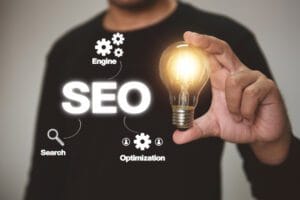What is SEO?
Search Engine Optimization (SEO) is the practice of enhancing your website to improve its visibility in search engine results pages (SERPs). The primary goal of SEO is to increase organic, non-paid traffic by aligning your content with what users are actively searching for online. In simple terms, SEO is about making your website more appealing and relevant to search engines like Google, Bing, and Yahoo, which ultimately helps your pages rank higher on search results.
Importance of SEO for Online Visibility
In today’s fast-paced digital world, search engines are the starting point for nearly all online activities. Whether you’re looking for a product, service, or information, your audience turns to search engines to find what they need. If your website doesn’t appear in the search results, it’s as if you’re invisible to potential customers.
Here’s where SEO plays a critical role. By improving your website’s SEO, you increase your chances of ranking higher on search engines, making your website more visible to users. This leads to increased organic traffic, more engagement, and, ultimately, more conversions for your business. SEO helps build your online presence, giving you a competitive edge.
How SEO Works
SEO works by making sure that your content aligns with the ranking criteria of search engines. But how do search engines determine which websites should appear first? They rely on sophisticated algorithms designed to analyze many different factors.
The Basics of Search Engine Algorithms
Search engines like Google use complex algorithms to rank web pages. These algorithms look at various elements such as:
- Content Quality: How relevant, comprehensive, and useful is your content to the user’s query?
- User Experience (UX): How easy is it for visitors to navigate your website? A smooth experience translates to longer visits and a better ranking.
- Backlinks: High-quality backlinks from authoritative websites signal to search engines that your content is credible.
- Technical Factors: How well your website is optimized for search engines, including loading speed and mobile-friendliness.
Crawling, Indexing, and Ranking Explained
SEO is based on three fundamental processes: crawling, indexing, and ranking.
- Crawling: Search engines send bots (also known as crawlers or spiders) to explore the web and discover new content. These bots follow links on web pages to identify new and updated content.
- Indexing: Once the bots crawl your website, the information is stored in a giant database called the index. Think of it as the search engine’s library.
- Ranking: When a user searches for something, the search engine retrieves the most relevant pages from its index and ranks them based on factors like content quality, authority, and user experience.
Understanding Search Engine Results Pages (SERPs)
The Search Engine Results Page (SERP) is the page that appears when a user performs a search query. It includes both organic search results and paid ads. Here’s a breakdown of what you typically see in a SERP:
- Organic Listings: These are the results that are ranked based on their relevance to the search query, not paid advertisements.
- Featured Snippets: These are specially formatted results that appear at the top of certain search queries, directly answering specific questions.
- Knowledge Panels: These appear on the right side of the search results, providing quick facts or summaries about entities like businesses, people, or organizations.
- Local Results: When users search for local businesses or services, Google displays local results on a map with business information such as address, phone number, and hours.
Types of SEO
SEO can be broken down into three main categories: On-Page SEO, Off-Page SEO, and Technical SEO.
On-Page SEO
On-page SEO refers to all the elements you can optimize on your website. This includes:
- Content Optimization: Ensure your content is high-quality, comprehensive, and relevant to the user’s query. Use keywords naturally within the content, keeping in mind the user’s intent and search behavior.
- Title Tags and Meta Descriptions: These are key elements for informing both users and search engines about the content of your page. Write engaging title tags and meta descriptions to improve click-through rates (CTR).
- Header Tags (H1, H2, H3, etc.): Using proper header tags improves readability and allows search engines to understand the structure of your content.
- Internal Linking: Linking between pages on your site helps establish a site hierarchy, making it easier for search engines to index your pages and helps users navigate your website more effectively.
Off-Page SEO
Off-page SEO refers to actions taken outside your website that affect your ranking:
- Link Building: Earning high-quality backlinks from authoritative websites helps establish credibility and trustworthiness. Search engines see backlinks as a vote of confidence.
- Social Media Signals: Although indirect, social media signals, such as shares and mentions, can drive traffic and engagement, which can help improve your SEO.
- Brand Mentions: Unlinked brand mentions also play a role in building your website’s authority and relevance in the eyes of search engines.
Technical SEO
Technical SEO focuses on the backend elements of your website, ensuring that it is easy for search engines to crawl and index your content. Key technical SEO aspects include:
- Site Speed: Google considers website speed a ranking factor. A faster website enhances user experience and can help improve search engine rankings.
- Mobile Optimization: With mobile search on the rise, Google prioritizes mobile-friendly websites. Ensure your site is responsive and performs well across devices.
- Site Architecture: A well-organized site with a clear URL structure, easy navigation, and clean code helps search engines understand and index your content.
Why SEO is Important for Businesses
SEO and Website Traffic
One of the primary reasons SEO is so important is its ability to drive organic traffic. Organic traffic refers to visitors who find your website through unpaid search results. Unlike paid advertising, which stops when you stop paying, SEO continues to work even after you stop paying. By ranking higher in search results, your website attracts more visitors, which in turn leads to increased conversions—whether that’s sales, leads, or sign-ups.
Improving User Experience through SEO
SEO isn’t just about ranking higher; it’s also about providing a better user experience. When your website is optimized for search engines, it is faster, mobile-friendly, and easier to navigate. These factors contribute to a lower bounce rate, higher engagement, and a more positive overall user experience, all of which are crucial for long-term success.
Long-Term ROI vs. Paid Advertising
While paid advertising brings immediate traffic, SEO offers long-term benefits. Once your pages rank higher, the traffic you receive is free. SEO enables businesses to build equity in their website over time, resulting in a sustainable flow of organic traffic, whereas paid ads require ongoing investment to maintain visibility.
Common SEO Mistakes to Avoid
- Keyword Stuffing: Overusing keywords to manipulate search rankings can lead to penalties. Focus on natural, user-friendly content that addresses the query in a meaningful way.
- Not Optimizing for Mobile: With mobile-first indexing, Google evaluates websites based on their mobile versions. Failing to optimize for mobile can harm both user experience and rankings.
- Neglecting Local SEO: If you have a physical business, optimizing for local search is essential. This includes setting up and optimizing your Google My Business listing, as well as building local citations.
SEO Best Practices
Regularly Update Content
Search engines love fresh content. Regularly adding new blog posts, articles, or updating existing content ensures that your website remains relevant. It also provides search engines with more pages to crawl, thereby improving your chances of ranking for additional keywords.
Build High-Quality Backlinks
Building quality backlinks is one of the most powerful SEO strategies. Focus on getting links from reputable, relevant websites in your niche. This can be done through guest blogging, partnerships, and creating shareable content.
Optimize for Featured Snippets
Featured snippets are the boxed information that appears at the top of some search results. Structuring your content in a way that answers specific questions (e.g., using bullet points, tables, or clear headings) can increase your chances of appearing in featured snippets.
Conclusion
SEO is a vital strategy for enhancing your website’s visibility, increasing organic traffic, and establishing credibility online. By understanding the nuances of SEO and adhering to best practices, you can improve your rankings and provide a more seamless user experience. While SEO is a long-term commitment, the benefits are more than worth the effort, offering lasting value and a competitive advantage.
Frequently Asked Questions (FAQs)
How long does SEO take to show results?
SEO is a long-term strategy, and it can take anywhere from 3 to 6 months to see significant improvements in rankings and traffic.
Can SEO help small businesses?
Yes! SEO is an effective way for small businesses to level the playing field against larger competitors by improving their online visibility without a large budget.
What is the difference between on-page and off-page SEO?
On-page SEO involves optimizing your website’s content and structure, whereas off-page SEO refers to activities such as link building and social media engagement.
Why is mobile optimization important?
Since Google uses mobile-first indexing, ensuring your website is mobile-friendly is crucial for achieving better rankings and an improved user experience.
How do I get started with SEO for my website?
Begin by conducting keyword research, optimizing your content, refining your site structure, and acquiring high-quality backlinks. Continue to monitor and adjust your performance accordingly.






